Vic is the capital of the old Carolingian county of Osona, and a place with a long history. There’s a standing Roman temple, to which we sadly didn’t get, but that belongs to the city of the site of pre-Roman Ausa, from which we get the county name of Ausona. That area stands away from the modern city which is built on the plain closer to the river, and seems to have been put there by none other than Count Guifré the Hairy some time shortly before 880.1 The historic centre is close by, however, because the cathedral was deliberately sited to take advantage of and reclaim the Roman site. And there, with none of the Carolingian fabric left but a fascinating set of strata of rebuilding visible in its walls, it remains:
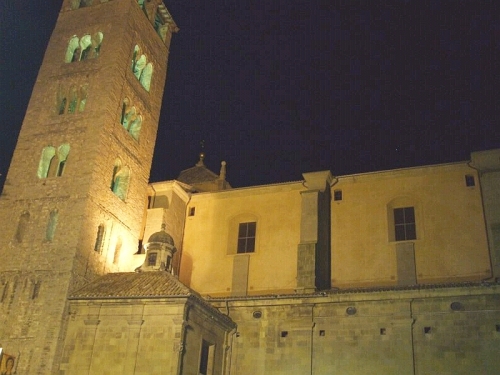
The oldest standing part of the cathedral now is the bell-tower, which dates to a rebuild in 1038 by Bishop Oliba, great-grandson of Guifré the Hairy and a complex figure who had been Count of the Ripollès before abandoning the world to become a monk at Santa Maria de Ripoll, that comarc’s main focus. Since he thus wound up as abbot there and at several other places, at the same point as his half-sister took over neighbouring Sant Joan de les Abadesses, whom he subsequently appealed as a “whore of Venus” before Pope Benedict VII, I’ve been known to wonder about how sincere and unpolitical that conversion was. But as his uncle Miró, who was one of the most educated men in Catalonia in his time, had seen no problem with being both Count of Besalú and Bishop of Girona, and Oliba turned out to be a liturgical and social innovator, I suppose he may just have been pushed into all the politics.2 Anyway, he is remembered at Vic, though not in a form that one would perhaps expect. Here he is:
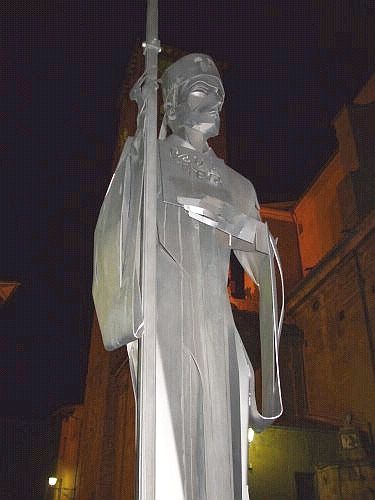
Metal! But in a nice way: the words on his chest, “Pau i Treva”, translate as ‘Peace and Truce’ and refer to his efforts to build a popular movement to limit knightly violence in his lands. That’s worth remembering him for, perhaps more so than for shopping his bastard sister for parricide and loose morals.3 So I was quite glad to see it, but again, it’s that sense I kept getting that round here the medieval history is an important explanation of political identity. I did try and get a picture of the metal bishop with the tower that he saw built as background, so as to make that connection visually again, but the strong light behind him basically made it unusable, and for a reason I don’t now recall it wasn’t possible to repeat it when I came back next day. We spent part of the evening in Vic, anyway, which is when these shots were taken, and my conclusion is that it’s a really nice city, but its liveliness is a little artificial. And it has a tremendous number of shoe-shops. I mean, a frightening and possibly apocalyptical number of shoe-shops. There is a lot of pig-farming round here, it permeated the rural atmosphere for miles around, and this may be part of an explanation, but it did seem as if Vic, like Cambridge again, was trying to drag in shoppers as an substitute for having any real purpose. (The silly thing with Cambridge being of course that it does have a purpose, and that the public transport and roads are so impassably minuscule that the number of shoppers they want could never reach the town. But moving back to the subject.)
An awful lot of what I have written about centres on Vic, if only because an awful lot of charter transactions I’ve used as evidence probably took place in that square where Oliba now glowers. The cool thing about that is that the evidence of this is also still there, in the Arxiu i Biblioteca Episcopal de Vic, and that was where I headed the next morning. It took us a little to find it in the skein of buildings around the cathedral—and the episcopal cats were uninformative:
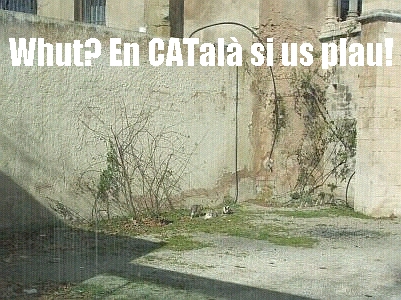
—but soon I found the door and knocked and was welcomed. Now, most Hispanists I’ve talked to have had some real horror stories about access to archives, of the “we only open one day a week for two hours in the afternoon. What day? Well, when do you go home? Wednesday? Thursday, then. And only if you speak Galician throughout so I can mock you. And you can’t actually touch anything and whatever it is you want to see most is locked and can’t be used” kind. So although I was rather hoping things would be better than that, as the places I wanted to go had, for example, websites, I wouldn’t have minded a war-story or two. In this I was completely disappointed. They had missed the e-mail in which I’d told them of my visit, but this was in no way a problem and didn’t prevent me being allowed, having just walked in off the street and showing no identification beyond English confusion and some shelfmarks, to have practically all their tenth-century charters out at once to look at:
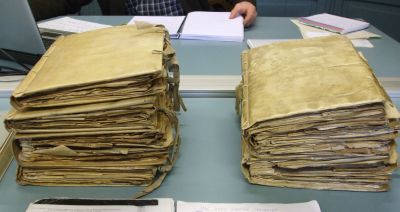
In this I principally owe thanks to Rafael Ginebra who was doing the fetching, and who had also previously done the indices for the biggest and most important charter edition I use, and has therefore saved me an incalculable amount of work.4 I also owe thanks however to the archivist, Miquel Sants i Gros, who was politely hauled out to show me the tenth-century papal papyri they also have here—in fact Vic has almost all of the surviving tenth-century papal papyri in the world—and about which I wrote something ages ago that may even some day make it to print. One of the things that a reviewer had to say about that paper was that it wasn’t at all clear I’d seen the things for real. And I hadn’t, indeed, but I’d worked from (and compared) two separate facsimile editions, one from before their restoration in 1928 and one after, the latter being far far easier to read, obviously, but also, I was concerned, perhaps too restorative.5 So working from the unaltered facsimiles actually seemed like better practice to me anyway. And seriously, what is the point of producing facsimile or even critical editions if work using them is automatically panned, eh? Calm down Jarrett, calm down. Right, yes. Anyway, so what I was doing in this archive was mainly heading off that sort of criticism…
… and also solving some of the questions that editions won’t let you answer, like, is that the same scribe Agelà who writes this other one? (It wasn’t, in any of the three cases, and a really good edition ought to tell you that clearly anyway, but there is a certain level of data you have to omit or never ever publish, of course; the relevant edition here took long enough anyway.6)
This left me flicking carefully through those volumes above, which have rows of three or four parchments stitched into a binding to make a kind of flap-book leaf, and then another set, and so on, till no more will fit. Individually, they look like this one:
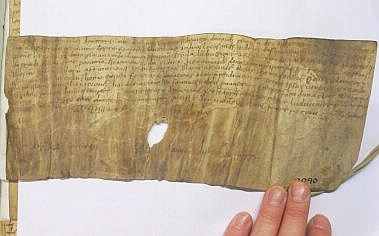
Let me give you an example of the sort of question I was trying to answer. In the edition of the Vic charters, the editor warns you of his no. 246, which is a bequest, that a legacy to Bishop Radulf is added in a different ink. As I’m continually trying to problematise the idea of charter production, people messing with charters is meat and drink to me, so I wanted to see the original, and actually it’s more interesting than you would suppose:
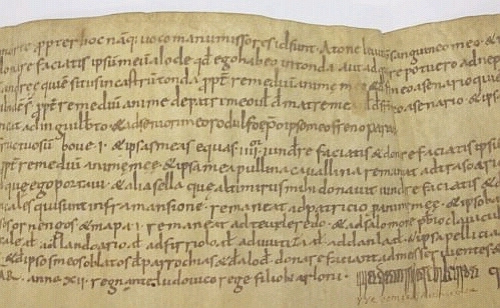
Now the bit we’re interested in is five lines down, the gap, and the clause in the middle there which, you can take my word for it, reads (with gaps between words and the abbreviation expanded): “& ad seniori meo rodulfo ep[iscop]o ipso meo freno parato”, ‘and to my lord Bishop Radulf my selfsame embroidered bridle”. This is interesting because it’s not, as I had thought, an afterthought or even a fraud; for a start, although you can hopefully see that it is in a different ink, it’s by the same scribe, the handwriting is the same. More to the point, the bulk of that line was apparently left blank when the charter was first drawn up, as if they were expecting more to come. And where they added the first extra bit that we now see, it’s all squeezed up tight, as if there was going to be another extra clause put in after that. So three phases of redaction minimum, except that the third one never happens. Not, in any case, an on-the-spot production but something planned, worked out, agreed on and then somehow unfinished. This is the sort of problematisation I mean.
Before I emerged from the archive, Dr Sants had very kindly given me a tour round the whole thing. It’s huge. It occupies most of the old episcopal palace, and the stuff they have in there made me feel goshdarned ungrateful to be an early medievalist, because there’s so much brilliant stuff sitting there, perfectly preserved in dry cold, not being used. What could you do, for example, with a series of parish registers that runs from the Spanish Civil War back to circa 1280? With marriage registers for a town running from the fourteenth century to the present day? And quite a lot of gorgeous manuscripts too. In only wanting to use some 700 of their earliest tatty fragments, I did feel as if I was missing a trick somehow. I do recommend a trip to look if you’re in search of a project, though you will need to speak at least French and preferably Spanish, or best of all Catalan. If you must speak Spanish, at least affect a foreign accent so that they know you know no better.
The other thing that we did once I’d emerged into the light was visit the Museu Episcopal de Vic, which is on the same square in a very modern building. It sounds a little parochial, and I suppose it is but this is my parrochia, and it is actually the main museum of the surrounding area; when a local church is dug, for example, the bits wind up here. That said, they also have a small but interesting collection of Ancient and late Antique Egyptian stuff, why I don’t know, and a really good numismatic display, including the only two coins that really might come from tenth-century Catalonia. They also have, and this is what I was really after, a stone slab from the early church that preceded the monastery of Sant Pere de Casserres, which is (I have now seen and can say) covered in inscribed names in eleventh-century hands and spellings, and raises all kinds of questions I’ll solve some day about acceptance and integration of the monastery (which was founded in 1006). They also have a seemingly endless collection of wooden statues of Madonna and child but the other stuff, and the Museu bookshop, which sold me several vital things I could never have got in the UK, more than made up for this slight obsession, which didn’t really float my boat, gorgeous though some of it was. What they didn’t have, as you may by now have guessed, was permission for people to take photographs, but their website is good even if the English-language sections don’t go very deep, and I do recommend having a poke round it (requires Flash).
So that was Vic, and we left it having bought stuff to eat a peasant-style lunch with and went in search of a castle, which I’ll tell you about later.
1. The standard work on the city, if their website there isn’t enough for you, is Ramon Ordeig i Mata, Els orígens històrics de Vic (segles VIII-X) (Vic 1981), but some account is to be had in English from Paul H. Freedman, The Diocese of Vic: tradition and regeneration in medieval Catalonia (New Brunswick 1983), online at http://libro.uca.edu/vic/vic.htm, last modified 17 August 2000 as of 22 March 2008.
2. Oliba has been unusual in attracting quite a lot of attention from English-language scholars. The classic work on him is still in Catalan, Ramon d’Abadal i de Vinyals, L’Abat Oliba, Bisbe de Vic, i la seva època (Barcelona 1948; 2nd edn. 1948; 3rd edn. 1962), 3rd edn. repr. as “L’Abat Oliba i la seva època” in idem, Dels Visigots als Catalans, ed. J. Sobrequés i Callicó, Estudis i Documents XIII-XIV (Barcelona 1969, repr. 1974 & 1989), II pp. 141-277. However, to this one can now add Adam J. Kosto, “Oliba, Peacemaker” in I. Ollich i Castanyer (ed.), Actes del Congrés Internacional Gerbert d’Orlhac i el seu Temps: Catalunya i Europa a la fi del 1r mil·lenni, Vic-Ripoll, 10-13 de novembre de 1999 (Vic 1999), pp. 135-149, and, more obtainably, Paul H. Freedman, “A Charter of Oliba before his Entry into Religious Life” in Robert F. Berkhofer III, Alan Cooper & Adam J. Kosto (edd.), The Experience of Power in Medieval Europe, 950-1350: essays in honor of Thomas N. Bisson (Aldershot 2005), pp. 121-128. If you should want to study the metal man here, every scrap of writing that he produced or that mentions him (except that one presented by Freedman in the previous reference) is edited in Eduard Junyent i Subirà (ed.), Diplomatari i Escrits Literaris de l’Abat i Bisbe Oliba, ed. Anscari M. Mundó, Memòries de la Secció Històrico-Arqueològica XLIV (Barcelona 1992), and in there the papal condemnation of Abbess Ingilberga and her nuns is Diplomatari no. 49. Note that Oliba’s nephew Guillem immediately got the nunnery’s spare lands to become Bishop of Besalú with (ibid., no. 10); obviously nothing set-up about that at all! Meanwhile, on the Count-Bishop Miró, see Josep María Salrach, “El Bisbe-Comte Miró Bonfill i la seva obra de fundació i dotació de monestirs” in Eufèmia Fort i Cogul (ed.), II Col·loqui d’Història del Monaquisme Català, Sant Joan de les Abadesses 1970 vol. II, Scriptorium Populeti 9 (Poblet 1974), pp. 57-81, with English summary pp. 422-423.
3. See Kosto, “Oliba”, and more generally on the Peace of God, Thomas Head & Richard Landes (edd.), The Peace of God: social violence and religious responses in France around the year 1000 (Ithaca 1992).
4. Rafael Ginebra & Ramon Ordeig, “Índex alfabètic de noms” in Ramon Ordeig i Mata (ed.), Catalunya Carolíngia IV: els comtats de Osona i Manresa, Memòries de la Secció Històrico-Arqueòlogica LIII (Barcelona 1999), 3 vols, Pt. 3, pp. 1355-1563.
5. The two editions are P. Kehr, Die ältesten Papsturkunden Spaniens, erläutert und reproduziert, Abhandlungen der Preussischen Akademie der Wissenschaften, Jahrgang 1926, Philosophisch-Historische Klasse, Nr. 2 (Berlin 1926), and Pontificum Romanorum Diplomata Papyracea quae Supersunt in Tabulariis Hispaniae Italiae Germaniae phototypice expressa iussu Pii PP. XI (Roma 1929). The paper is called “Archbishop Ató of Osona: false metropolitans on the Marca Hispanica” and I hope to have it resubmitted some time in the latter part of this year.
6. That edition being E. Junyent i Subirà (ed.), El Diplomatari de la Catedral de Vic, segles IX i X, ed. R. Ordeig i Mata (Vic 1980-1996), 5 fascs, in which these two charters are nos 247 & 246 respectively.

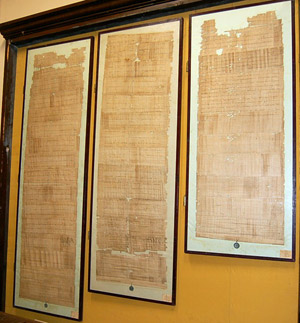

Added more info on your blog to my linked post.
Many thanks. I was quite pleased with the pictures so I feel vainly keen to be named for them…
Pingback: In Marca Hispanica XXIV: still welcome in Vic | A Corner of Tenth-Century Europe
Pingback: Seven men in a high castle | A Corner of Tenth-Century Europe
Pingback: More curiosities of the Beaulieu cartulary documents | A Corner of Tenth-Century Europe
Only just discovered this post. Vic is actually one of the best archives for me at the moment as an early(ish) modernist, and I really wish they had better opening hours. But Rafel Ginebra couldn’t have been any more helpful the times I have visited and actually took some digital photos for me on one occasion.
Glad you’ve found it, and also that someone else is using the archive. It has such potential, though if as many people as could benefit from it were to use, Rafel would have too much to cope with by a long way!
Pingback: In Marca Hispanica XXXII: my questions answered | A Corner of Tenth-Century Europe
Pingback: In Marca Hispanica XXXIII: parts of Vic previously unreached | A Corner of Tenth-Century Europe